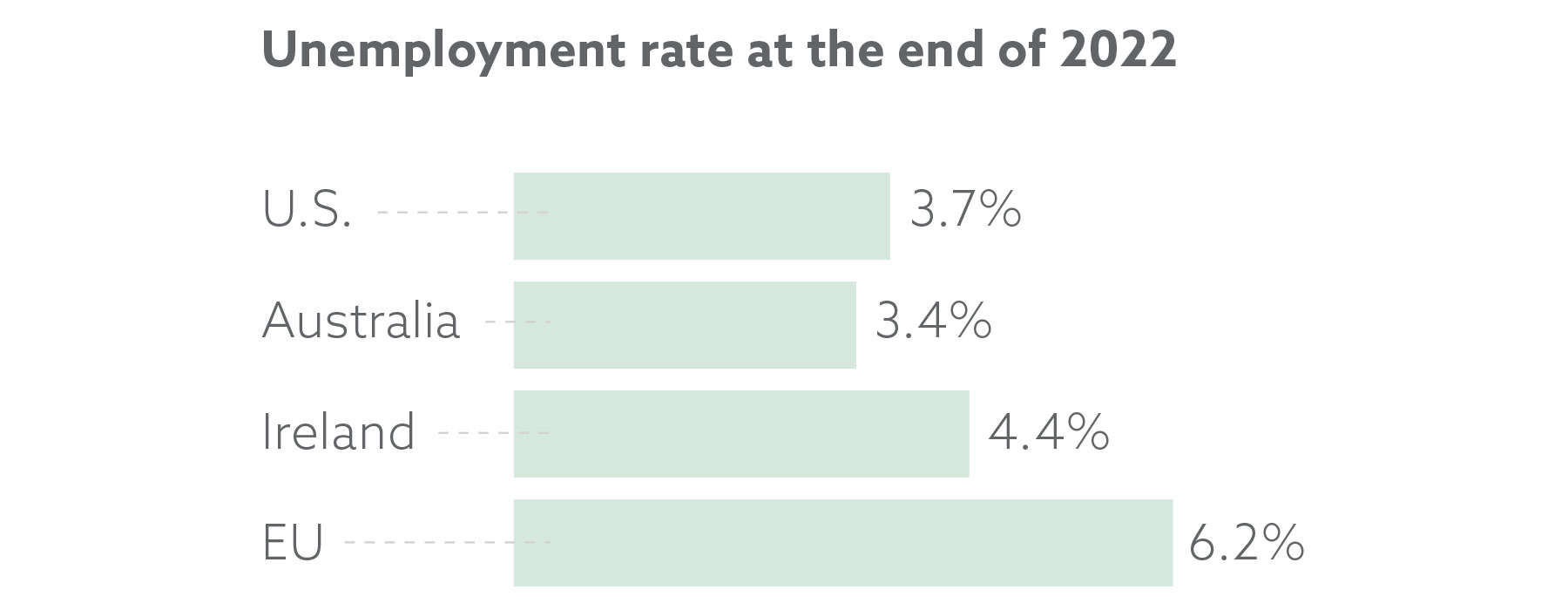CONTRIBUTORS
Ruth Leggett
CEO, Ireland, Sedgwick
Angela Hornby
director of capability, Australia, Sedgwick
We can be cautiously optimistic that the workforce upheaval sparked by the COVID-19 pandemic and other global factors has begun to subside somewhat. That said, employers will surely continue to feel tremors in 2023 and likely well beyond.
Seismic business, social and political shifts are still shaking organizational foundations. The war for talent shows little sign of abating, which means employers will continue to deal with ongoing staffing problems and the resulting employee stress and burnout. To support their workers and maintain productivity, forward-thinking organizations are looking beyond flexible schedules and hybrid work policies to rethink some of their employment models and strategies.

The experienced are exiting
Here’s why innovative workforce solutions are needed: This decade is shaping up to become one of the most volatile in history for employers worldwide. In 2021, 48 million people left their jobs in the U.S. alone. In 2022, it’s estimated an additional 20% opted to exit, and many aren’t returning. In some industries, such as construction and retail, periodic job losses are expected; however, this go-around, the job exodus is predominantly among skilled workers, especially in the service industries. According to the U.S. Chamber of Commerce, financial activities and business and professional services are the two categories with the highest talent shortages.
While regions such as the European Union, Australia and Asia have had fewer losses than the U.S., they also face employment concerns. The EU’s employment rate is near 70%, but new challenges, including resignations by more experienced workers, are emerging.
Furthermore, attitudes about work are evolving. Although work-life balance has been discussed for years, the pandemic and its related physical and mental health issues finally pushed legions of employees to reprioritize and rethink their approach to work. As a result, many workers are now pushing back against the discretionary effort of long hours and overtime.
This trend protects workers from job demands that may be overwhelming, but it does carry a cost for employers. The U.S. Bureau of Labor Statistics reports that productivity fell at a 7.5% annual rate in the first quarter of 2022 and 4.1% in the second. It did rise slightly toward the end of 2022, but productivity overall is still down. Many analysts believe that disengagement, fueled by various factors, is a pivotal contributor to the decline.
A fresh approach to managing talent
Whatever the impetus, employers are seeking a path to solid ground for both their organizations and their employees. According to Gallup’s State of the Global Workplace: 2022 Report, well-being has become the new workplace imperative to fight descending recruitment and retention trends. The study notes, “Well-being and engagement interact in powerful ways. Employees who are engaged and thriving experience significantly less stress, anger and health problems. The relationship between well-being and engagement is vital because how people experience work influences their lives outside work, and overall well-being influences life at work.”

One innovative strategy for tackling the challenges — from productivity to engagement to mental health and beyond — is adopting resource or staffing management. These flexible and scalable workforce management solutions are designed to support organizations through projects, workload peaks and employee absences/leaves.
Many employers, especially in the insurance industry, consider resource solutions during catastrophes or surges, such as when a product recall or natural disaster occurs and claim volumes increase quickly and significantly.
However, other issues can also impact an employer’s productivity and operations. For example, employee stress claims are at an all-time high. The Gallup study also reports that 44% of U.S. employees experienced “a lot of daily stress” the previous day. Stats like this are one reason why mental health claims are increasing globally. In Australia alone, they are set to double by 2030.
Just as an organization might deploy resource solutions during a surge or catastrophe, it’s time to make that option the norm to help in managing employee stress, burnout and other workforce challenges and improving engagement and productivity. A smarter workforce management strategy, resource solutions can:
- Fill gaps, offset demand, and minimize the burdens pressuring existing employees
- Counter emerging challenges that add to workforce stress and impact quality and productivity
- Ensure a skilled team can quickly step in to perform tasks, support, and even help train existing employees
- Support targeted initiatives that would otherwise push existing employees beyond the limits of their established roles, such as business transformation or mergers and acquisitions.
A resource solution program assures a ready pool of experienced and vetted workers. These colleagues can fill any role an employer may need, from payroll, auditing, financial, claims, adjusting and case management to financial, customer service, clerical and other vital functions.
Whether it’s an insurer that needs loss adjusters following a natural disaster in Australia, an administrator in Germany experiencing an influx in claims or demand for a forensic accountant to serve a fraud prevention program in Florida, employers no longer need to burden their current workforce and cause more anxiety and stress. Instead, a resource management partner can rapidly fill the open positions.
Here’s a typical scenario: A large insurer in Ireland notes a dramatic increase in motor claims due to the recent surge in car rentals. The company was already facing challenges finding personnel, and current employees reported high job dissatisfaction rates — making staff retention critical to ongoing operations.
The insurer decides to work with a resource solutions provider to bring on a team of claims adjusters and a head of compliance, a position they’ve struggled to fill.
The colleagues are brought on for six months, helping to bridge the gap and alleviate stress on the existing team. The compliance expert works out well and ultimately transitions from a temporary position to a full-time employee.
These skilled colleagues can work for as little or as long as needed. For example, the Sedgwick resource solutions team has placed people with client organizations for as little as two weeks and even up to 15 years.
Another benefit of this approach is the ability to navigate the strict regulatory and compliance guidelines regarding industrial relations. With a resource team, you have the flexibility to bring on new colleagues when needed and for whatever reason is best for your organization.
Ensuring a dependable and skilled workforce
One key benefit of an experienced resource solutions partner is its ability to recruit, retain, and continually train a workforce that ensures the right people are available for the right positions at the right time.
While markets have been volatile, unemployment rates are at historic lows in many parts of the world. (See chart below.)

Further fueling employers’ talent woes is the fact that many professionals today are opting out of traditional jobs. Leaning into the gig economy, they are instead pursuing flexible opportunities that give them the independence to work from anywhere — a phenomenon sometimes referred to as “seas or trees” changes. Shortages of available talent interested in full-time work are making it difficult for organizations to find new hires.
However, those same issues present opportunities for companies offering robust resource solution programs. Strong partners can help employers look at these challenges through a fresh lens — providing not just staffing but also acting as a resource for training and development and helping employees better manage the pressures of modern work. The result is innovative talent solutions at the ready to address current and emerging issues. They can enable organizations to continue meeting their goals while protecting what global businesses are finally embracing as their most valuable asset: their people.
To that end, some global employers are moving toward recruiting globally with the support of a resource solutions partner and allowing members of their workforce to complete remote work in any location of their choosing (subject to international regulations). That’s enticing for today’s highly mobile workforce — from Gen Zers seeking flexibility to baby boomers looking to ease into the final phases of their careers.
2023 won’t be business as usual
While much uncertainty remains with regard to the global marketplace and workforce challenges, we can make a few predictions, including:
- The employment market will remain tight for the foreseeable future
- Employees will continue to experience stress and anxiety
- Productivity and engagement strategies will be vital to employers’ success
One way to manage the uncertainty of today’s market is to establish strong partnerships with solution providers that are there not only when there is a natural disaster or crisis but whenever employees need additional support. The right resource solution partners know clients take on a level of risk when they entrust their programs to an outside group — and they must work to earn and maintain their clients’ confidence through a daily commitment to them. They don’t function merely as a staffing agency; they become an extension of their clients’ operations.
With the complexity of today’s globalized business environment, it’s ill-advised to think that any one organization can be everything to everyone. Strategic partnerships enable companies to augment their offerings, fill in gaps in expertise and infrastructure, and leverage technology and talent in ways that yield a whole greater than the sum of its parts.

